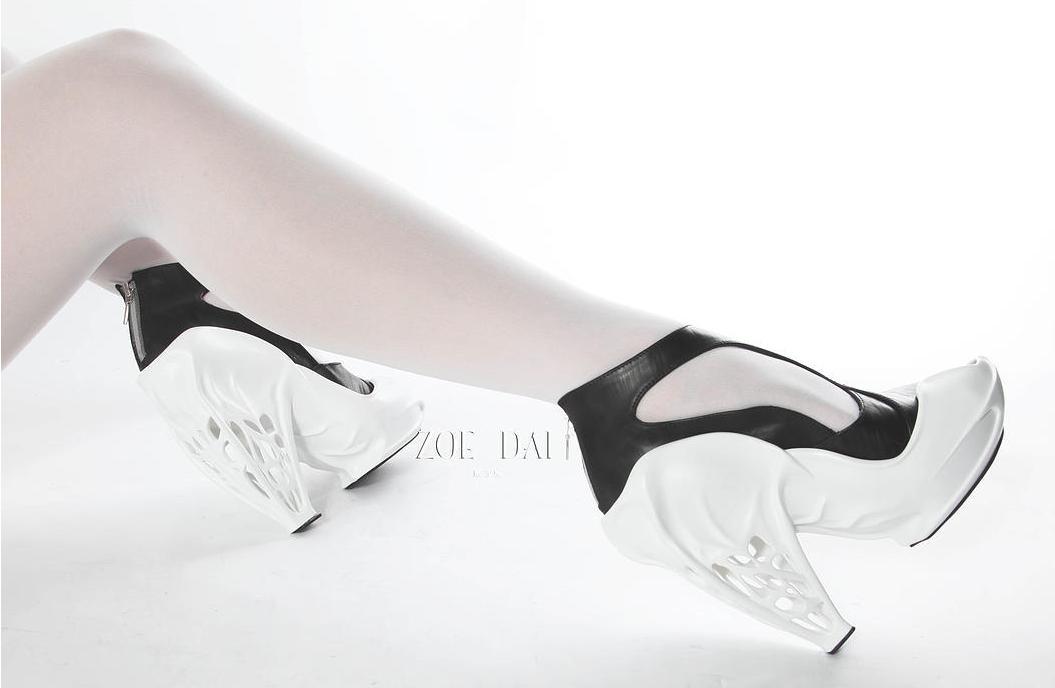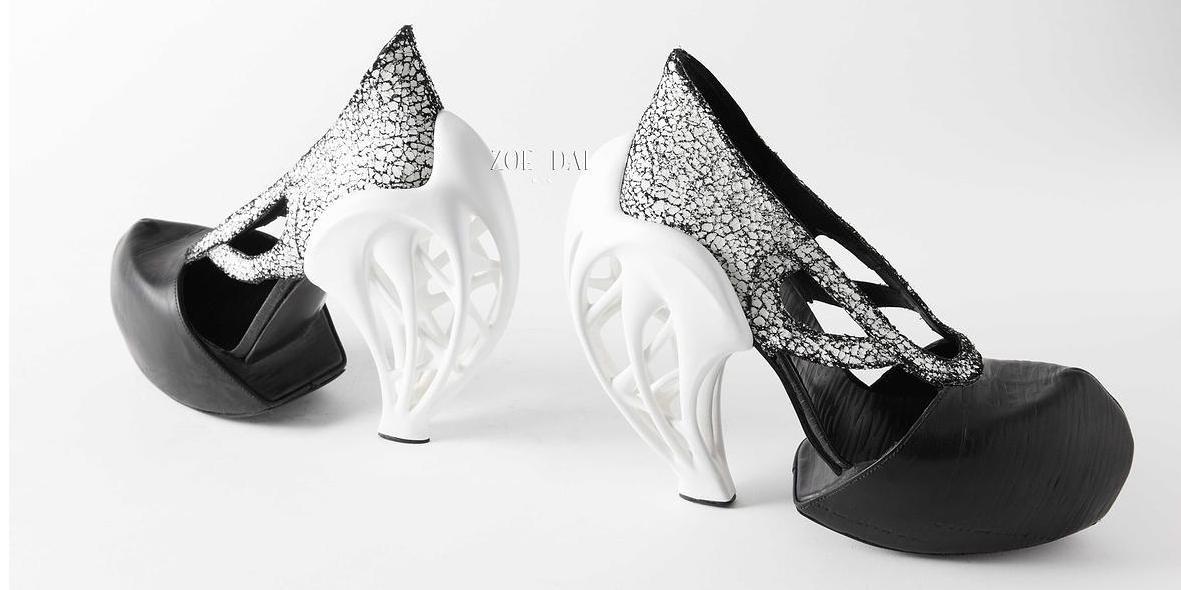 3D printing and fashion are beginning to converge as designers around the world are starting to see the potential that the technology provides for making completely custom clothing and accessories which fit the wearer to a T. One such designer, is a woman named Zoe Jia-Yu Dai, who has recently released her latest shoe collection, titled “Breaking the 3D Mould”. Her designs combine more traditional shoe making methods with the modern day technology of 3D printing. We recently had the opportunity to interview Dai, and ask her about what goes into creating such a unique produce.
3D printing and fashion are beginning to converge as designers around the world are starting to see the potential that the technology provides for making completely custom clothing and accessories which fit the wearer to a T. One such designer, is a woman named Zoe Jia-Yu Dai, who has recently released her latest shoe collection, titled “Breaking the 3D Mould”. Her designs combine more traditional shoe making methods with the modern day technology of 3D printing. We recently had the opportunity to interview Dai, and ask her about what goes into creating such a unique produce.
Would you be able to provide me with some background for your “Breaking the 3D Mould” collection?
Zoe Dai: Breaking the 3D Mould is the latest shoe collection I created for my final project of the master at London college of Fashion; it was finished in December of 2014.
What gave you the idea for these shoes?
Zoe Dai: My original interest in creating a partly 3-D printed shoe came from a desire to look at ways to change the process of footwear manufacturing. It was clear that 3-D printing could not only achieve this, but would also allow a large amount of flexibility in the design stage, as well as allowing me to push the limits of design structures. Whilst completing my masters in footwear design, I was able to use these ideas to combine modern technology (3-D Printing) and the traditional shoe making techniques to create the whole shoe collection. The process did indeed allow me to push the boundaries in the design phase as well as allowing for prototyping, and the process created a clear distinction between traditional techniques of footwear manufacturing and the techniques I employed. I pushed the physical limits of design materials, and created designs that would be impractical or even impossible to produce with traditional manufacturing methods such as machining or moulding.
Furthermore, I was interested in combining concepts from organic, natural structures and modern technology. I found the contrast between cutting-edge technology and nature fascinating. Additionally, I have always appreciated how natural structures and living organisms look, and I wanted to utilize these natural structures in my design work. This was especially well-suited to this project as these complex structures are not easily produced by traditional machining. Another key point for me was that shell, fossil and bone are used in nature to support or protect animals. Bone is a crucial part of a creature’s body, supporting their weight in a similar way to a shoe supporting the weight of the wearer. 3-D printing technology allowed me to incorporate these design ideas into my work with every complex structure possible, and I could even create more detail in my designs.
How do you go about designing these shoes?
First I gather materials and inspiration from different museums and galleries in London or abroad. These objects inspire my concept ideas. I utilized theses inspirations that I gathered into my design work to create my 3-D printed shoes. It was a process which started with hand drawings and finished with designs being reproduced using 3-D software. Once a design was made on paper, this needed to be transformed into a 3-D model using computer software. For my collection, this involved the heel of the shoe. This process can take some days, depending on the complexity of the heel. Once the design is completed, using the software, it is either printed directly in the case of prototypes, or sent to a manufacturer when the EOS 3-D printer was required. The finished product is then attached to the shoe to form the heel.
What 3D printers do you use to print them on?
2 different types of 3-D printer were used to create my shoe collection. The first type was an FDM (Fused Deposition Modeling) printer that was used for prototyping. The second type of 3-D printer was an EOS (Electro Optical Systems) printer that was used for manufacturing the final shoe heels, as this gave a superior finish.
How are they assembled together?
My shoe collection combines the modern technology (3-D Printing) with a high level of craftsmanship, using traditional shoe making techniques. As the shoemaking production involves several complicated stages, I will briefly describe the construction process.
- The first stage was to create individual 3-D printed lasts, based on the scans of a client’s foot. The custom-made lasts were created by a 3-D scanner, coupled with 3-D software and a 3-D printer. The shoe lasts must represent the anatomical information of the foot, whilst at the same time giving the finished shoe a pleasing and fashionable appearance.
- The second stage was to create the shape of the shoes, a process which started with hand drawings and finished with designs being reproduced using 3-D software. The heel shapes were then printed out by an FDM 3-D printer as prototypes.
- The third stage involved creating the shoe upper, which involved embossing patterns onto leather. The patterns were embossed using a stamp created in 3-D design software and printed using an FDM 3-D printer. This stamp was then used to transfer the embossing pattern onto the leather.
- The fourth stage came from traditional shoemaking, and involved making the shoe upper process. The traditional methods of the pattern cutting, stitching the leathers, and making the insole and outsole were used in this stage. The last is the form over, which the shoe uppers are moulded.
- The fifth stage involved printing out the shoe heels using an EOS 3-D printer, and the heels were then spray-painted with white coloring.
- The final stage was the process of assembling the upper and heel of the shoes together. There is a video I made for showing the construction process (see below)
My design inspirations for this collection came from natural structures, such as shells, fossils and bones, which are used to support or protect animals. Another inspiration was organic shapes already used in art. For example, The Bone Chair created by Joris Laarman and the Sagrada Familia designed by Antoni Gaudi. Further inspiration derived from natural textures. I utilized theses inspirations into my design work to create my 3-D printed shoes.
Have you had any hurdles to overcome with your design process?
The biggest hurdle was how to intelligently apply this advanced technology to my shoe design and combine this technology with traditional shoe making techniques, rather than 3-D printing the whole shoe. Shoe making is highly skilled and needs to be precise in areas such as structure and proportion. Each 3-D printed heel needs to precisely fit the shoe whilst simultaneously considering the overall aesthetics. The heel also needs to perform its primary purpose of supporting a person’s weight.
I remember one of my heels, which was designed based on a cage. When it was printed with an FDM printer used for prototyping, I had to put support structures inside the heel, otherwise the model could not be built. Then my co-worker and I tested it several times, and we successfully printed it out in the end. We changed the model’s position in the FDM printer and chose the appropriate 3-D printing material as well as adjusting the temperature of the printer. Many times experiments using this technology allow me to gradually realize how to solve the problems I encounter.
Are you selling these designs?
I am selling the shoe collection after June of 2015, but I haven’t decided on a final price yet. It’s hard to calculate the real cost of the collection because there has been a large time investment used on creating the designs, experimenting with materials, etc. Those who are interested in my shoes can either email me (zoe0931@yahoo.com.tw) or they can visit ZOE DAI’s website.
Subscribe to Our Email Newsletter
Stay up-to-date on all the latest news from the 3D printing industry and receive information and offers from third party vendors.
You May Also Like
Profiling a Construction 3D Printing Pioneer: US Army Corps of Engineers’ Megan Kreiger
The world of construction 3D printing is still so new that the true experts can probably be counted on two hands. Among them is Megan Kreiger, Portfolio Manager of Additive...
US Army Corps of Engineers Taps Lincoln Electric & Eaton for Largest 3D Printed US Civil Works Part
The Soo Locks sit on the US-Canadian border, enabling maritime travel between Lake Superior and Lake Huron, from which ships can reach the rest of the Great Lakes. Crafts carrying...
Construction 3D Printing CEO Reflects on Being Female in Construction
Natalie Wadley, CEO of ChangeMaker3D, could hear the words of her daughter sitting next to her resounding in her head. “Mum, MUM, you’ve won!” Wadley had just won the prestigious...
1Print to Commercialize 3D Printed Coastal Resilience Solutions
1Print, a company that specializes in deploying additive construction (AC) for infrastructure projects, has entered an agreement with the University of Miami (UM) to accelerate commercialization of the SEAHIVE shoreline...































